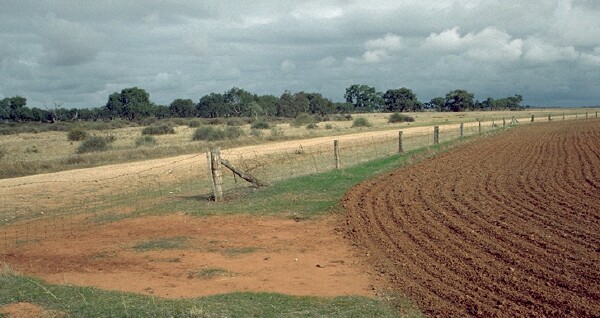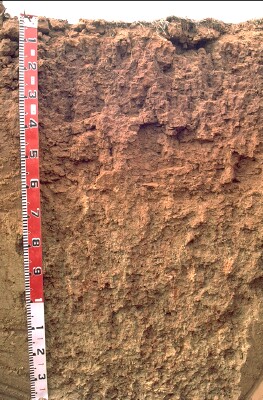LP120
| Group: Bendigo Creek Floodplain Group | Australian Soil Classification: Vertic (and Hypocalcic), Mesonatric, Red SODOSOL |
| Northcote Factual Key:Dr 3.13 | Great Soil Group: red-brown earth |
| General Landscape Description: Level plain very close to Bendigo Creek | Geology: Alluvial deposits (Quaternary). Shepparton Formation |
 LP120 Landscape |
Soil Profile Morphology
Surface Soil
| A1 | 0-8 cm | Dark brown (7.5YR3/4), fine sandy clay loam; weakly structured; very firm consistence when moderately moist; pH 6.5; sharp change to: |  LP120 Profile |
| Subsoil | |||
| B1 | 8-40 cm | Dark reddish brown (5YR3/4), light medium clay; strong coarse blocky structure; strong consistence when moderately moist; slickensides evident from 30 cm; pH 7.9; gradual change to: | |
| B21 | 40-60 cm | Strong brown (7.5YR4/6), medium clay; moderate medium sized blocky structure; very firm consistence when moderately moist;; pH 9.2; clear change to: | |
| B22 | 60-70 cm | Yellowish brown (10YR5/6), medium clay; moderate medium sized polyhedral; very firm consistence when moist; few (5%) gypsum crystals and few (4%) soft carbonates; pH 7.9; clear change to: | |
| B23 | 70-120 cm | Brown (10YR5/4) with yellowish red mottle (5YR4/6), medium clay; weak coarse prismatic structure, breaking to moderate coarse blocky structure, breaking to strong fine polyhedral structure; strong consistence when moist; very few soft and hard carbonates (<2%) and very few manganese stains (1%) in lower part of horizon; pH 9.0; clear and wavy change to: | |
| B24 | 120-140 cm | Reddish brown (2.5YR5/4) with yellowish red (5YR4/6) clay bands (20% of horizon), light medium clay; very firm consistence when moist; up to 10% manganese stains in the upper part of this horizon; pH 8.8. | |
Key Profile Features
- Strong texture contrast between surface (A) horizons and subsoil (B) horizons.
- Vertic properties (slickensides) throughout the subsoil.
- Shallow surface soil.
Key Profile Characteristics
pH | Salinity Rating | |||
Surface (A1 horizon) | slightly acid | very low | sodic | moderately dispersive |
Subsoil (B21 horizon) | slightly alkaline | very low | strongly sodic | strongly dispersive |
Deeper subsoil (at 120-140 cm) | strongly alkaline | low | strongly sodic | slight-moderately dispersive |
 |
Management Considerations:
Surface (A) Horizon
- Shallow surface horizon. Care should be taken to retain this top 8 cm as the horizon below will be more difficult to manage if exposed.
- The surface soil is sodic and dispersive which will result in restricted root and water movement in the soil. Water is likely to build up on the surface after heavy rains causing waterlogging and surface runoff. This problem may be exacerbated if the soil is disturbed in a moist condition. This condition may cause root penetration and seedling emergence problems. The addition of gypsum may ameliorate this problem. A test strip could be used to assess the likely benefits.
- The surface horizon has a low inherent fertility (based on the sum of the basic exchangeable cations).
- Organic carbon levels show that organic matter content is relatively low for the surface soil from this pit. Organic matter is important for enhancing soil aggregation, fertility and water holding capacity on soils such as this with such a high fine sand content. Organic matter levels will build up under pasture but will decline if cultivation takes place. Practices such as residue retention, minimum tillage and including pasture rotations should be utilised if cropping occurs.
Subsoil (B) Horizons
- The coarsely structured upper subsoil is sodic and dispersive which will result in restricted root and water movement in the soil. Water is likely to build up in the surface horizon (as it is more porous) after heavy rains causing waterlogging and surface runoff.
- The deeper subsoil (from 40 cm depth) is strongly alkaline which indicates that some nutrients (eg. copper, iron, manganese, and zinc) may be poorly available to deeper rooted plants.
- The subsoil displays vertic properties (ie. presence of slickensides) which indicates that significant shrinking and swelling occurs with wetting and drying cycles. This may disturb the roots of some plant species and has engineering implications (eg. disturbance to building foundations and fencelines).
Comments from Landholder:
- 1992 had crop of oats and was undersown with clover.
- No record of gypsum or lime application.
- Superphosphate has been applied.
- The soil in the 120-140 cm horizon is locally known as “swamp cement”.
Notes
- Profile described by Paul Rampant and Ruth Lourey (23/5/96)


